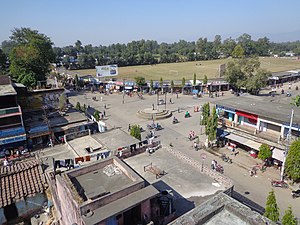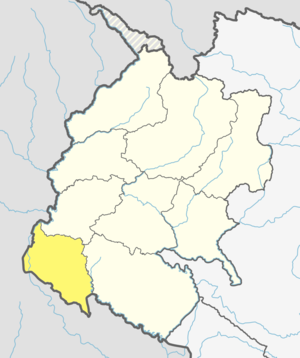Kanchanpur District
कञ्चनपुर जिल्ला | |
|---|---|
 Madan Chowk at Bhimdatta municipality | |
 Location of Kanchanpur District | |
 Divisions of Kanchanpur District | |
| Coordinates: 28°50′N 80°20′E / 28.833°N 80.333°E | |
| Country | |
| Province | Sudurpashchim Province |
| Established | 1860 |
| Administrative Headquarters | Bheemdatta |
| Municipality | |
| Government | |
| • Type | Coordination committee |
| • Body | DCC, Kanchanpur |
| • Head | Mr. Phairu Tamang |
| • Deputy-Head | Mrs. Sanu Kumari Budthapa |
| Area | |
• Total | 1,610 km2 (620 sq mi) |
| Population (2011) | |
• Total | 451,248 |
| • Density | 280/km2 (730/sq mi) |
| Time zone | UTC+05:45 (NPT) |
| Main Language(s) | Doteli (37.9%), Tharu (25.4%), Nepali (16.1%), Baitadeli (5.2%), others (15.4%) |
| Major highways | Mahendra Highway |
| Website | ddckanchanpur |
Kanchanpur District (Nepali: कञ्चनपुर जिल्ला [ˈkʌnt͡sʌnpur] ), a part of Sudurpashchim Province in the Terai plain, is one of seventy-seven districts of Nepal. The district, with Bhimdatta as its district headquarters, covers an area of 1,610 square kilometres (620 sq mi) and had a population of 134,868 in 2001 and 171,304 in 2011.[1][2] It is located in south-western of Nepal. It is bordered by Kailali district in the east, Dadeldhura district in the north and with India in the south and west.
Before the reunification of Nepal by Gorkha King Prithvi Narayan Shah, this district was part of the Doti Kingdom. Nepal lost it to the East India Company after the Anglo-Nepalese war (1814–1816). Then the Kingdom of Nepal and the East India Company followed by territorial concessions of Sugauli Treaty.[3] Later on after the treaty of 1860, Nepal recovered this land along with Kailali, Banke and Bardiya. Its first headquarters was Belauri Municipality, and the current headquarter, Mahendranagr, was declared in 2019 B.S.
The majority of the population is ethnic Tharu community, and minor groups are the peoples that have migrated from the northern hilly region. The district is renowned for Shuklaphanta National Park and the 1,456.97 metres (4,780 ft) long multi-span suspension bridge over Mahakali River.
Jhilmila Lake, Bedkot Lake, Bandatal, Shovatal, and Vishnu Temple, Ranital are the other tourist attractions.
- ^ "National Population and Housing Census 2011(National Report)" (PDF). Central Bureau of Statistics. Government of Nepal. November 2012. Archived from the original (PDF) on 18 April 2013. Retrieved 28 July 2015.
- ^ "Districts of Nepal (Population, Area & Capital)". Statoids. 7 December 2012. Retrieved 7 December 2012.
- ^ "History of Nepal Army". Official website of Nepal Army. Archived from the original on 28 December 2017. Retrieved 18 May 2017.